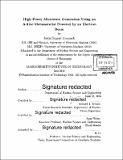| dc.contributor.advisor | Richard J. Temkin. | en_US |
| dc.contributor.author | Hummelt, Jason Samuel | en_US |
| dc.contributor.other | Massachusetts Institute of Technology. Department of Nuclear Science and Engineering. | en_US |
| dc.date.accessioned | 2017-01-30T19:17:36Z | |
| dc.date.available | 2017-01-30T19:17:36Z | |
| dc.date.copyright | 2016 | en_US |
| dc.date.issued | 2016 | en_US |
| dc.identifier.uri | http://hdl.handle.net/1721.1/106771 | |
| dc.description | Thesis: Ph. D., Massachusetts Institute of Technology, Department of Nuclear Science and Engineering, 2016. | en_US |
| dc.description | Cataloged from PDF version of thesis. | en_US |
| dc.description | Includes bibliographical references (pages 205-210). | en_US |
| dc.description.abstract | This thesis presents the theory, design, and experimental demonstration of coherent microwave generation at 2.4 GHz in a metamaterial loaded waveguide using a 490 keV, 84 A, one microsecond pulse length electron beam that produced more than 5 MW of microwave power. Three different metamaterial structure designs named MTM1, MTM2, and MTM3 were tested with design frequencies of 2.8, 2.4, and 3.7 GHz, respectively. The waveguides were loaded with two metamaterial plates that were machined with complementary split ring resonators with periods ranging from 5 to 10 mm. The metamaterial waveguides supported two distinct modes: a symmetric mode that occurs when the two metamaterial plates were excited in phase, and an antisymmetric mode that occurs when the metamaterial plates were excited out of phase. The electron beam propagated on axis between the metamaterial plates. The output radiation was studied for solenoid magnetic field values in the range 350 to 1600 G and for beam voltages from 350 to 500 kV. The best results were found in a 370 mm long structure using the MTM2 design, where output power levels of up to 5 MW were obtained at 400 G in the antisymmetric mode at a frequency near 2.39 GHz. The frequency tuning vs. magnetic field for operation at a power level exceeding 1 MW was consistent with that predicted by an anomalous Doppler shifted resonance condition, [omega] = [kappa]z[upsilon]z - [Omega]c/[gamma]. At magnetic fields above 750 G, the microwave output switched to the symmetric mode at a frequency near 2.44 GHz, but the power level dropped drastically to below 100 W. In contrast to the antisymmetric mode, the frequency tuning of the symmetric mode was consistent with that predicted by a normal Cherenkov resonance, [omega] = [kappa]z[upsilonl]z. CST PIC simulations predict the observed output frequencies and the switch between modes at 750 G. However, the CST simulations also predict multi-megawatt power levels in both modes, which was observed in the antisymmetric mode, but not the symmetric mode. The discrepancy between the symmetric mode output power of the simulations and experiment Is unexplained. To the authors knowledge, these are the first reported experimental results of high power (> 1 MW) microwave generation from an electron beam interacting with a metamaterial structure. The results are important for the development of new microwave sources and novel devices which utilize active metamaterials | en_US |
| dc.description.statementofresponsibility | by Jason Samuel Hummelt. | en_US |
| dc.format.extent | 210 pages | en_US |
| dc.language.iso | eng | en_US |
| dc.publisher | Massachusetts Institute of Technology | en_US |
| dc.rights | MIT theses are protected by copyright. They may be viewed, downloaded, or printed from this source but further reproduction or distribution in any format is prohibited without written permission. | en_US |
| dc.rights.uri | http://dspace.mit.edu/handle/1721.1/7582 | en_US |
| dc.subject | Nuclear Science and Engineering. | en_US |
| dc.title | High power microwave generation using an active metamaterial powered by an electron beam | en_US |
| dc.type | Thesis | en_US |
| dc.description.degree | Ph. D. | en_US |
| dc.contributor.department | Massachusetts Institute of Technology. Department of Nuclear Science and Engineering | |
| dc.identifier.oclc | 969903944 | en_US |
